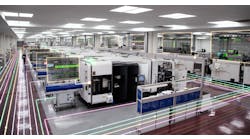Collision sensors mechanically detect when robot arms encounter obstructions. They absorb the crash energy and quickly stop the robot to prevent costly damage to robot arms and tooling.
One shop found another use for them. Collision sensors solved problems that involved a robotdriven grinding/ deburring operation needed to ensure consistent part finishes. Grinding wheel wear was inconsistent, and simply incorporating offsets was not effective.
The shop incorporated a RAD (www.rad-ra.com) Ultimatic Collision sensor as a compliance device with a signal to determine how much the robot needed to adjust its positioning in response to wheel wear.
After a set number of cycles, the robot reduces the air pressure to the Ultimatic. The robot then moves toward a predetermined solid object until the tool touched with enough force to trip the sensor.
The signal sent from the collision sensor to the robot lets the robot know where the workpiece is and, consequently, how much it needed to adjust its program path so that the worn grinding wheel was touching the part but not gouging it.
Once this program was complete, the air pressure to the Ultimatic was adjusted to a level that made it a rigid coupling once again.
RAD’s pneumatic Ultimatic collision sensors feature repeatabilities of 0.0005 in. and allow users to adjust the amount of resistance the units must overcome before stopping the system. Other RAD collision systems include the pneumatic High- Angle Ultimatic, pneumatic Spring- Assist Ultimatic, pneumatic Stainless Ultimatic, and the spring-loaded Uni- Coupler.






